
This is a list of the National Register of Historic Places listings in Grand Forks County, North Dakota. This is intended to be a complete list of the properties and districts on the National Register of Historic Places in Grand Forks County, North Dakota, United States. The locations of National Register properties and districts for which the latitude and longitude coordinates are included below, may be seen in an online map.
The Masonic Center is a Renaissance style building in Grand Forks, North Dakota. It was designed by architect Joseph Bell DeRemer and was constructed by the Dinnie Brothers in 1913. It replaced the first Masonic Temple in Grand Forks, which had burned, and which was later reconstructed as the Stratford Building.

Wright Block is a property in Grand Forks, North Dakota that was listed on the National Register of Historic Places in 1982.
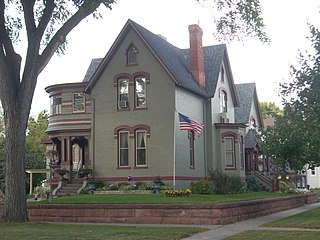
The Dr. Henry Wheeler House is a property in Grand Forks, North Dakota, United States, that was listed on the National Register of Historic Places in 1986. It was built in 1884 or 1885. It was probably designed by George Wheeler, a New York architect, younger brother of Henry. It includes Italianate architecture. The property includes just one contributing building, the house. Also included is one non-contributing building, a more modern garage. The listing is for an area of less than 1 acre (0.40 ha). The listing is described in its NRHP nomination document.

The Telephone Co. Building in Grand Forks, North Dakota, United States, was built in 1904. It was listed on the National Register of Historic Places in 1982.
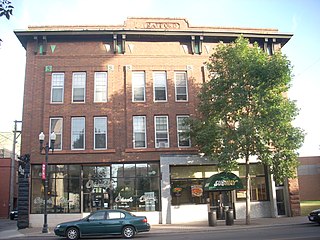
The Stratford Building is a property in Grand Forks, North Dakota that was listed on the National Register of Historic Places in 1982.
The Flatiron Building was an historic building in Grand Forks, North Dakota, that was built in 1906 and was destroyed by the 1997 Red River flood. It was listed on the National Register of Historic Places, but was removed from the Register in 2004 because it had been destroyed.
The Grand Forks Near Southside Historic District is a 182-acre (74 ha) historic district in Grand Forks, North Dakota that was listed on the National Register of Historic Places (NRHP) in 2004.
Clifford Annex was a building in Grand Forks, North Dakota. It was listed on the U.S. National Register of Historic Places, but was destroyed in the 1997 Red River flood, and was delisted in 2004.

The Iddings Block is a property in Grand Forks, North Dakota that was listed on the National Register of Historic Places in 1982. It was one of 13 new commercial business block buildings built in Grand Forks in 1892, and is one of just two surviving from the 1888-1892 era. During 1892 to approximately 1906-1909, it was the location of Iddings and Company, the largest bookstore and stationer in the state in that period. In 1981, it housed Ruettell's.
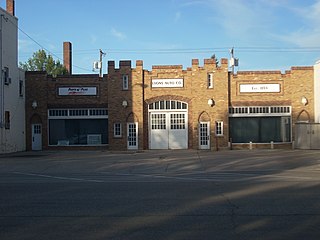
Lyons Garage is a building in Grand Forks, North Dakota that was built in 1929 and was listed on the National Register of Historic Places in 1982. The rectangular building was built as an expansion of an adjacent Lyons Auto Supply company building that had been built in 1912. The 1912 building is not included in the National Register listing.

Dinnie Apartments is a building in Grand Forks, North Dakota, United States. It was listed on the National Register of Historic Places (NRHP) in 1994. Dinnie Apartments is included in the Grand Forks Near Southside Historic District, which was listed on the NRHP in 2004.

Oxford House is a building on the University of North Dakota campus in Grand Forks, North Dakota, United States that was listed on the National Register of Historic Places in 1973.

Grand Forks station is a property in Grand Forks, North Dakota, United States, that was listed on the National Register of Historic Places in 1982 as the Northern Pacific Depot and Freight House. It was used both as a passenger station and a freight warehouse/depot by the Northern Pacific Railway.

The Hook and Ladder No. 1 and Hose Co. No. 2 is a property in Grand Forks, North Dakota that was listed on the National Register of Historic Places in 1982. It is locally significant as one of two fire stations built by the city in 1907. The other, at time of NRHP nomination, was condemned.
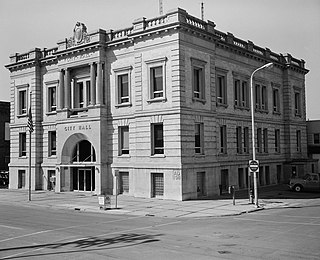
John W. Ross (1848–1914) was the first licensed architect in Grand Forks, North Dakota.

Speed Printing is a building in Grand Forks, North Dakota that was listed on the National Register of Historic Places in 1982.

Grand Forks County Courthouse is a Beaux Arts style building in Grand Forks, North Dakota that was listed on the National Register of Historic Places in 1980. It is a "richly decorated white limestone structure in a modified Classical Revival style, topped with a massive cast iron dome."
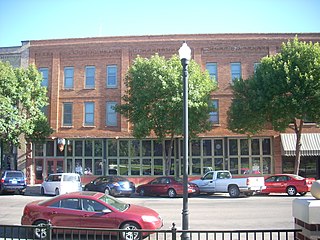
Grand Forks Mercantile Building is a property in Grand Forks, North Dakota that was listed on the National Register of Historic Places (NRHP) in 2004. Built in 1898, the building includes Early Commercial architecture. Though the design has in the past been attributed to Grand Forks architect John W. Ross, the architects were Stoltze & Schick of La Crosse, Wisconsin.

The New Hampshire Apartments in Grand Forks, North Dakota were listed on the National Register of Historic Places in 1982. They were built in 1904 at a cost of $26,000 and were significant as a building designed by architect Joseph Bell DeRemer. The apartments were an example of commercial vernacular architecture, and the building was the first in Grand Forks to have a planned second-story-level walkway to another building. When listed on the National Register, the apartment complex was one of few remaining downtown structures designed by DeRemer with classical details. It was built by the Dinnie Brothers, a construction firm that was established in 1881 and was at one time responsible for the building of more than 60 percent of the commercial buildings in Grand Forks.



















